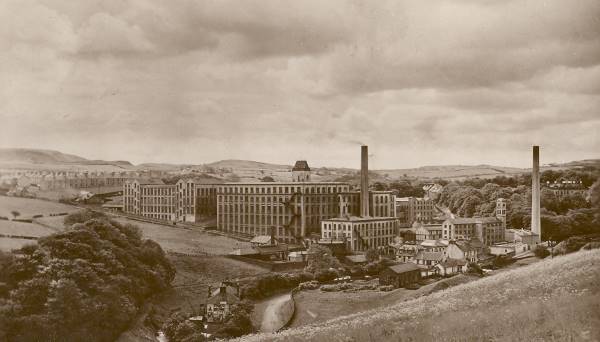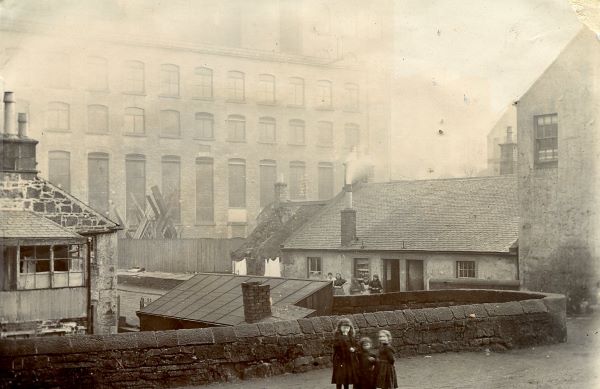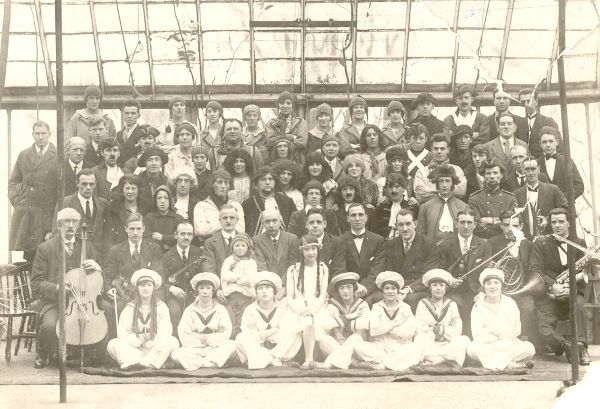

History of Neilston
Read on to discover the origins of Neilston
Neilston has a long and fascinating history. It was an established settlement for hundreds of years before it’s emergence as a hub of the textile industry, during the industrial revolution. This article gives an overview of some of the key points in the village’s history.
Early History
Neilston Parish was part of the lands granted by King David I to his High Steward, Walter Fitz Alan, in the 12th century and grew to play an important role as a centre for religion and for administration. Walter seems to have granted the area to one of his followers, Robert de Croc, who then provided the lands necessary to support a chapel at Neilston. When his patron Walter founded a priory at Paisley in 1163, Robert gave these lands to the new priory.
Neilston Parish was much larger than the village itself. It was bounded on the north by Paisley, on the east by Eastwood Parish, on the south by Mearns and Stewarton, on the south-west by Dunlop and on the west by Beith and Lochwinnoch and included the area of present day Barrhead.
The Industrial Revolution
Neilston remained relatively unchanged over time until the mid-eighteenth century, when the Industrial Revolution changed the way people lived forever. Neilston was ideally situated for the textile industry, with the River Levern providing the water for the processes and power it required. A profusion of bleachfields, printworks and cotton mills began to line the course of the river and it was this that led to the growth of neighbouring Barrhead.
The Crofthead Mill was established in Neilston in the 1790s and by 1830, it was the biggest producer of spun cotton of all the mills on the Levern and was still expanding. In 1859, the company merged with R. F. & J Alexander who owned the mill at Duke Street, Glasgow. The original mill burned down in 1883 but was replaced by a series of buildings, many of which still stand today. In 1898, Alexander’s joined the English Sewing Cotton Company Limited. Duke Street was closed and the whole business became concentrated at Crofthead. By 1900 the mill employed around 1,500 people from Neilston but also from neighbouring areas, such as, Barrhead, Pollokshaws and even Glasgow.

Another cotton mill was opened at Broadlie in 1792 by a Mr. Airston of Nether Kirkton. It was bought over by Pollok, Gilmour & Co who extended it. By 1854 it had become a flax mill. Later it was occupied by Hugh McConnel & Co. for yarn dyeing and then became Clyde Leather Co.
A bleachfield was established at Kirktonfield by John Cochran in 1820 and this became another important employer in the village. The factory was bought by James McHaffie & Co. who bleached and finished fine textiles such as shirting. In their heyday, they employed up to 300 workers.
Like other areas in East Renfrewshire, the population of Neilston expanded dramatically during the industrial revolution. People were attracted to the area by opportunities to work in the mills and factories where they could earn higher wages than they could as agricultural workers.
However, it was still a hard life for most people both at work and at home. They would work 12 hours days in a 6 day working week and there was no exception for child workers. In 1805 the government passed the Health and Morals of Apprentices Act which limited children’s hours to 12 hours a day, with the last 2 being spend on rudimentary education. To accommodate this, factories built schools on-site, which became known as ‘half-timer schools’. One such school was built at Crofthead and survived until the end of the 19th century. The biggest transformation in children’s lives came with the Compulsory Education Act of 1872 which stipulated that children had to attend school between the ages of 5 and 13.
Long working hours and a life of poverty for most meant that social activities were limited. Social interactions often revolved around the many inns and public houses, where alcohol was sold at cheap prices. However, it was also a place to gather, to exchange news and gossip and many clubs and societies had their origins in the village pub.
As the century moved on and working conditions, hours and pay gradually improved, villagers began to look for more ways in which to spent their leisure time. Organisations began to evolve; from sporting clubs to amateur dramatics and social events took place, often in small privately run halls. At the end of the 19th century the Glen Halls were gifted to the village by Mrs. Margaret Glen of Carlibar (Lady Glen) providing a spacious venue for all types of meetings and social events.
Development of the Village
Prior to the Industrial Revolution, settlement in the area was sparse and scattered. The village would have had a relatively small number of dwellings, probably occupied by the tradesmen essential to any community: blacksmiths, joiners, coopers, bakers etc. There were two farms in the area of the village, Kirkstyle on High Street and Broadlie Farm on Broadlie Road and extending beyond this was a wide-spread farming community.
The new factories and mills required a higher concentration of workers and this created a demand for housing. Works owner built blocks of housing, sometimes called ‘Lands’ which they would rent to their workers. These usually consisted of rows of single or two storey buildings divided up into separate dwellings. In Neilston new communities grew up at Crofthead, the Brig (junction of Holehouse Brae and Loch Libo Road), Wylies Land (on the Low Road) and Low Banks (just before the Broadlie Mill) to name but a few. Accommodation would be cramped and basic with large families inhabiting only 1 or 2 rooms.

Many single women came to the village, particularly on a seasonal basis to work in the bleachfields and at Kirkton Bleachfield a ‘Woman House’ was built to accommodate them. This hostel style housing was home to around 150 women and was still in use until the beginning of the 20th century.
In contrast to this, the owners and managers of the works lived a much more luxurious lifestyle. They began to build grand houses, usually near their works. In 1830, James Orr, the then owner of the Crofthead Mill, built Crofthead House, on two acres of the farm of Cowdenhall, which the company had feued from William Mure of Caldwell. (1) Later his son Robert, built a new mansion on the land, calling it Cowden Hall and demolished Crofthead House.
The first more modern development came in 1900, when the owners of Crofthead Mill decided to build 400 houses for their workers at the Holehouse end of the village. These were very modern for the time and built in an English style. They survive today in Lintmill Terrace, Orr Terrace, Molindinar Terrace and surrounding streets.
The Twentieth Century
The Crofthead Mill continued to dominate the life of the village throughout most of the 20th century, until its final closure in 1992, although it moved into the production of thread rather than cotton spinning.
In the early part of the century there was a brief period of unrest amongst mill workers, due to a dispute, between the women of the cop-winding department and the mill managers, over a reduction of rates of pay due to changes to the speed of the machinery. The cop winding department went on strike on the 16th May, gaining the attention of the The National Federation of Women Workers, who became involved and organised rallies and marches. On 6th June, the entire workforce joined the strike and there was a march on the 10th June to the managers house in Pollokshields. The strike eventually ended on the 20th June when the management promised that there would be no drop in pay.
There had never been a history of class struggle between mill owners and workers in Neilston. Even in 1880, during the ‘Weaver’s Revolt’ when all the other Renfrewshire mills were out, Crofthead kept going.
An indication of the generally good relations was evident when mill owner Robert Orr died in 1910. His mansion, Cowden Hall, was taken over by the company and used as a recreation centre for the workers. The grounds were used for tennis and bowling and the house was used for amateur dramatics. Many plays and concerts were performed at the Glen Halls by the Cowden Hall Dramatic Club to much acclaim. The cast of the 1927 performance ‘Paul Jones’ are shown below in the conservatory of Cowden Hall.

The house was also used as a convalescent home for British and Belgian soldiers during WW1. Neilston did not escape the clouds of the Great War and many of the village men signed up to the local regiment (6th Battalion Argyll & Sutherland Highlanders) and were sent to the front. Over 160 of them never returned home. In the 1920s there was a national movement to erect war memorials in villages and towns to commemorate the fallen, but for some reason Neilston did not build one. In 2015, after much research and fundraising, the Neilston War Memorial Association, with much local support, unveiled a poignant memorial in the centre of the village.
Although local industry gradually declined over the course of the 20th century, Neilston continued to adapt and grow as a residential area. There has been a gradual spread of modern housing and the village has developed modern amenities serving the local population, many of whom work in Glasgow, Paisley or elsewhere. The village has a range of shops and businesses, two primary schools, a sports centre and a library as well as a community owned and operated venue, The Bank.
References:
(1) Sweeney, Dan, Postscript to the Past, Glasgow, 2015 p.9
Further Reading:
Bobbins & Threads, Memories of Neilston Mill, Glasgow, 2009
Drennan, Matt & Fergus, Keith, Barrhead & Neilston: Then & Now, Neilston 2018
Hood, John, Old Barrhead and Neilston, Stenlake, 2011
Hughson, Irene, Bygone Barrhead, Stenlake, 1993
Hughson, Irene I., Barrhead and Neilston in old Picture Postcards, European Library, 1985
Laws, J J, The Neilston Story: A Personal View, Neilston Community Council, 1988
Pride, David, A History of the Parish of Neilston, Alexander Gardener, 1910
Semple, A History of the Parish of Neilston
